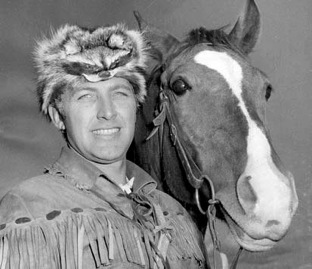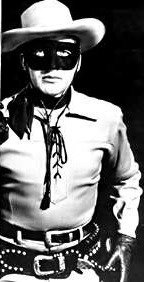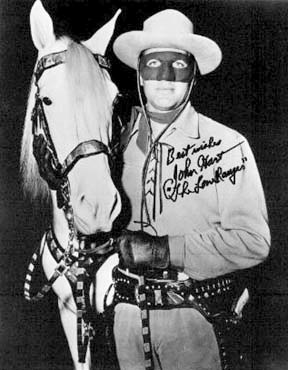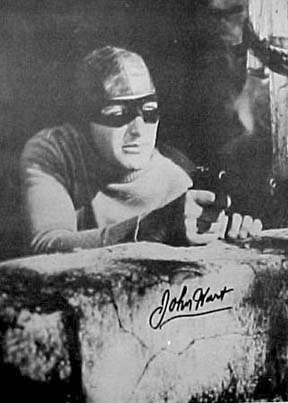John Hart
d. September 20, 2009
Who else played the Lone Ranger on television?
John Hart, 91, the B-movie, serial and TV actor whose career highlight was the answer to a trivia question, died Sept. 20 at his home in Rosarito Beach in Baja California. He had dementia.
Clayton Moore, who died in 1999, is a beloved idol of the first TV generation for his portrayal of the masked man through most of the show’s run (1949 to 1957 on ABC). But Hart replaced him in 52 episodes shot after Moore fell out with the producers (Jay Silverheels played Tonto through the entire run with both Moore and Hart). In those early days of filmed TV series, production was not always divided neatly into seasons. Moore starred in some 78 episodes made in 1949 and 1950 that ran during the show’s first three years on the air.
When production was set to resume in 1952, Moore asked for a salary increase that producer George W. Trendle, who created the Lone Ranger in 1933 for his Detroit radio station, refused to pay. Casting about for a replacement, Trendle settled on Hart, who had played another famous radio hero brought to film in Columbia’s 1947 “Jack Armstrong” serial. Hart spent the 1940s as a supporting player in numerous action programmers, B-westerns and serials (including “Brick Bradford,” “Batman and Robin” and “Atom Man vs. Superman”), and he had played a villain in several episodes of The Lone Ranger with Moore.
No matter who played the Lone Ranger, Trendle and sponsor General Mills ground out the shows as quickly and cheaply as possible. “We worked Monday through Saturday,” Hart told the Longmont, Colo., Daily Times in 2001. “The scripts ran 30-some pages. We shot every episode in two days.”
Hart also noted with amusement that the Ranger’s famous horse Silver and Tonto’s horse Scout did not get along. “They hated each other, it was really funny,” he said. “We’d pull up and have some dialogue and the horses would start nipping at each other and dancing around.” The misbehaving horses often forced the actors to shoot their close-ups in saddles mounted on sawhorses, Hart said.
Those who have seen Hart’s Lone Ranger episodes generally agree that he was a poor substitute for Moore, whose real talent lay in his ability to effortlessly project the Ranger’s authority and charisma from behind the mask. Hart appeared stiff and charmless in comparison. Preparing to shoot a further 52 episodes in 1954, Trendle settled his differences with Moore, who was happy to regain the role after being forced back into his pre-Ranger work as just another player in B-westerns and serials. Trendle also was happy to have Moore back since he was preparing to sell every asset connected with The Lone Ranger to producer Jack Wrather. Hart was cut loose to appear in some I Love Lucy episodes and to find work in segments of Sky King, Fury, Sergeant Preston of the Yukon (another Trendle property that went to Wrather), Highway Patrol, Bat Masterson and Tales of the Texas Rangers among others.
In 1955, Hart starred in Columbia’s “Adventures of Captain Africa,” one of the last movie serials made, in a role that not so coincidentally required him to wear a Ranger-like mask. The cliffhanger started production as another adventure of the masked jungle hero of comic-strip fame, The Phantom, subject of a 1943 Columbia serial. Only after shooting started did the producers discover their rights to the character had expired. Production halted just long enough for Hart to be outfitted in a slightly different mask and hood and dubbed Captain Africa.

Hart landed another TV series lead in 1957 as early-American frontier scout Hawkeye in Hawkeye and the Last of the Mohicans, rather loosely based on the James Fenimore Cooper story. The syndicated series ran for 39 episodes, with Lon Chaney Jr. co-starring as Chingachgook.
Hart continued to appear in small roles in films like “The Shaggy Dog,” “The Horizontal Lieutenant,” “It Happened at the World’s Fair,” “The Cincinnati Kid,” “Captain Newman, M.D.” and “Marnie,” and in episodes of Leave It to Beaver, Ben Casey, Rawhide, The Lieutenant, The Addams Family, Perry Mason, Hec Ramsey, Barbary Coast and CHiPs. But as acting jobs fell off, he also got into business, producing educational and sales films and selling film stock. In 1981, he became associate producer and post-production supervisor of Jack Klugman’s series Quincy for its last two seasons.
And surprisingly, Hart revisited the Lone Ranger several times, first in “The Phynx,” a 1970 low-budget spy spoof made long after the 1960s spy craze ended. The plot had Albanian spies kidnapping American celebrities who played themselves in cameo appearances — everyone from Georgie Jessel, Guy Lombardo and Johnny Weissmuller to Ed Sullivan, Joe Louis and Colonel Harland Sanders. Hart and Jay Silverheels played themselves playing the Lone Ranger and Tonto.
Even more surprisingly, Hart stepped in for Clayton Moore again when Moore once again ran afoul of the Lone Ranger’s owners. After playing the Ranger for the last time in the 1958 feature “The Lone Ranger and the Lost City of Gold,” Moore retired from the screen and created a second career by virtually becoming the Lone Ranger, appearing in costume at rodeos, hospitals, Savings Bond rallies, parades, in public service announcements and commercials. That lasted until 1979, when the huge success of “Star Wars” and “Superman” triggered a spate of big-budget features reviving classic adventure heroes. Wrather planned to cash in with a splashy new Lone Ranger movie.








